Dominique Luchart's Blog, page 560
July 23, 2021
Can rocky worlds exist between alien gas giants?, ,

A wild variety of star systems exist in the nearby regions of the Milky Way, and astronomers are eager to know where they might find an “Earth 2.0,” or an Earth-size exoplanet that has liquid water and orbits in the habitable zone of its parent star.
Now, new simulations show that it’s possible for an Earth-like planet to arise in pretty much the last place you might look: between the orbits of two giant worlds. And there may be such an example right on our doorstep.
Those weird neighborsMeet 55 Cancri, a binary star system located about 41 light-years from Earth, in the direction of the constellation Cancer. The main star in that system is a main-sequence star that is slightly smaller than the sun but much more enriched in heavy metals such as iron. Besides that high metallicity, though, it’s a pretty average star.
But it’s not alone; it has a binary companion, a small red dwarf orbiting over 1,000 astronomical units (AU) away from it. (One AU is the average distance between Earth and the sun — about 93 million miles, or 150 million kilometers.)
Related: 7 ways to discover alien planets
This star system also has a lot of planets. And they’re big. 55 Cancri hosts four planets packed closer to their star than Earth is to the sun. The nearest planet to the main star of 55 Cancri has a mass eight times that of Earth, with an orbit closer than Mercury’s orbit around the sun. Next come three massive beasts: two that are 50 times more massive than Earth and one with almost the mass of Jupiter.
The last known planet in that star system is a world that has a mass almost four times Jupiter’s and that orbits a mere 5 AU from its star.
But those are just the known planets in that system; there might be more planets tucked inside, especially smaller ones that we cannot detect yet. Exoplanet detection methods have a much easier time finding giant worlds that are close to their parent stars, because those systems are more easily detectable. But it’s also possible for smaller or more distant worlds to exist in all of the exoplanet systems we’ve studied.
On the shoulders of giantsA team of researchers recently used a suite of planetary formation simulations to determine if the 55 Cancri system could potentially host more Earth-size planets.
Their simulations looked specifically at the region of the system between the fourth and fifth planets, in the star’s habitable zone, or the region where a planet might be able to retain liquid water on its surface (not too close and hot for all the water to boil off, and not too far away that it might freeze).
Because of the sheer amount of computational resources needed to fully simulate the planet-formation process in these hundreds of scenarios, the researchers adopted a statistical approach: They began their simulations with a protoplanetary disk (a rotating disk of gas and dust surrounding a newly formed star) composed of 500 Mars-mass embryonic protoplanets, and allowed them to collide, merge and splinter.
The researchers found that even though the giant planets gobbled up most of the inventory of raw materials for planet making, there was still plenty of material left to make an Earth-size world. What’s more, the gravitational influence of those massive worlds did not disrupt the planet-making process in between them, the team wrote in a paper recently published to the preprint database arXiv.
From hundreds of simulations of potential starting conditions, the researchers found that an Earth-like planet could potentially form in the 55 Cancri system. Given what we know about protoplanetary disks and what it takes to build a system of such giants, that Earth-like world could have as much as six times the water inventory of Earth.
However, from the simulations, the researchers found that such an Earth-like world would have only a 10% chance of lying within the habitable zone of 55 Cancri and would, therefore, likely be a frozen water world.
Nonetheless, the results show that Earth-like planets can potentially form in systems that host a number of giant, close-packed worlds. The findings open up more potential for discovering habitable worlds in other stellar systems and potentially increase the chances of finding an Earth 2.0 in a place where we wouldn’t expect to look.
Follow us on Twitter @Spacedotcom and on Facebook.
The post Can rocky worlds exist between alien gas giants?, , appeared first on NEWDAWN Blog.
Apple MagSafe Battery Pack review: convenience over capacity, Dieter Bohn
 The Apple MagSafe Battery Pack on an iPhone 12 Mini
The Apple MagSafe Battery Pack on an iPhone 12 MiniApple’s new MagSafe Battery Pack is a white rectangle you can stick to the back of an iPhone 12 to charge it. It’s Apple’s third run at designing an external battery solution for the iPhone and I like it better than the earlier battery cases.
However, anybody considering spending $99 on this battery ought to keep one important fact in mind: even Apple cannot break the laws of physics. It is just as bound by the same rules of magnetism and electrons as everybody else.
Those laws require tradeoffs: A battery that could fully charge up most iPhone 12 models would be big. A battery small enough to not look odd on a phone wouldn’t have enough juice. Plus, electrons can only flow so fast without building up heat and degrading the battery.
Apple found a balance between all those extremes and it maintains that balance with a tight software integration that aggressively manages how this battery charges your phone. The result is a gadget that’s singularly focused on the iPhone — sometimes to its own detriment.
The best part about the MagSafe Battery is that it also serves as a fast-charging wireless MagSafe puck when it’s plugged in. So the big question is whether all that is enough to justify the price, especially compared to the competition.
The MagSafe Battery doesn’t have enough energy to fully charge an iPhone 12 Mini from zero to 100 percent.
In my testing, the MagSafe Battery was fully drained when my iPhone 12 Mini reached 83 percent, which took 130 minutes of charging. I didn’t have it plugged in for this test, which meant it charged at a relatively pokey 5W speed, so as to minimize heat and maximize the battery’s longevity.
I used the iPhone very sporadically during the charging period (mostly to record the results every 15 minutes), though I did listen to a 15-minute podcast over Bluetooth which slowed the charging down a bit.
Bottom line: it’s a small battery and it will help you top up your iPhone, not fully charge it. On larger iPhone 12 models, it won’t even hit that 83 percent.
 The screen that appears when you attach the MagSafe Battery.
The screen that appears when you attach the MagSafe Battery. The MagSafe Battery Pack on an iPhone 12 Pro Max.
The MagSafe Battery Pack on an iPhone 12 Pro Max.There is a discussion to have about what the right way to talk about battery size is. The MagSafe Battery only has a 1,460mAh battery, but that number isn’t comparable to other batteries because it can push through more volts (7.62V). So the MagSafe Battery’s rated 11.13Wh (Watt-hours) is the number that actually matters. Meanwhile, Anker makes a 5,000mAh battery with wireless charging and magnets for under $50. It’s rated at 18.5Wh, so the differences are smaller than they first appear.
The battery measurement discussion is interesting, but it doesn’t change the fact that the MagSafe Battery is simply small. It’s meant to be pocketable and easy to carry, and so you should think of it as something that can stretch your battery life just a little — not get you through multiple days away from a charger.
As you might expect, the software experience with the MagSafe Battery is tightly integrated into the iPhone. There are big animations that show the charge of both your phone and the battery when you attach it. It shows up on the battery level widget, too.
More interestingly, when you first attach the battery, your iPhone will pop up a notice that this battery won’t charge your phone above 90 percent — by design. Those last few percentage points put a lot of stress on batteries, and in this context it’s just not worth it. I think it’s a smart move, but if you absolutely want that last 10 percent, you can long press the battery icon in the Control Center and tell it to charge past 90 percent.
 An Anker battery next to the MagSafe Battery.
An Anker battery next to the MagSafe Battery. The Anker battery is a bit larger, but it also has a larger battery inside.
The Anker battery is a bit larger, but it also has a larger battery inside.I know this sounds both complicated and disappointing, but in use it’s actually the opposite. I would just slap the battery on the back of my phone when I was worried about battery life and didn’t sweat the details. The result was not needing to keep an eye on battery life as much as I usually do. It’s elegant instead of powerful.
That’s all smart, but it only happens with the iPhone. It is certainly a nicer overall experience than you’d get with the Anker battery, which is thicker to boot. But the Anker has other advantages. Its battery is bigger, for one thing. It also has a USB-C port on it that both takes charge when plugged in and can be used to charge devices via a wire. It’s less elegant for iPhone users, but it’s much more versatile.
The Lightning port on the bottom of the MagSafe Battery means iPhone users can keep using the same charging cable, so it’s probably the right call to keep it. It’s just too bad that Lightning can’t charge in either direction like a USB-C port can.
 The Apple MagSafe Battery Pack nearly perfectly fits the iPhone 12 Mini.
The Apple MagSafe Battery Pack nearly perfectly fits the iPhone 12 Mini.The MagSafe Battery is designed to match the dimensions of the iPhone 12 Mini perfectly. It aligns exactly to the edges and is more comfortable to hold than I expected. If you have a larger iPhone, it will sit on the back a bit more awkwardly — it looks positively tiny on the iPhone 12 Pro Max.
 The MagSafe Battery Pack looks a little funny on an iPhone 12 Pro Max.
The MagSafe Battery Pack looks a little funny on an iPhone 12 Pro Max.I polled Twitter for questions about the battery and I was taken aback by the vitriol I saw in my replies — and elsewhere. It’s easy to make fun of how a battery pack looks on the back of a phone. It’s also easy to go after it for not providing enough charge. Having used it, I’m not sure I’d want it any larger and I certainly wouldn’t want it any smaller. To me, there’s no such thing as a good-looking external battery. At the end of the day, they’re all squarish or oblong hunks of plastic or metal.
The white plastic has a matte finish that helps a little with grip, but I wouldn’t call it soft touch. I do wonder if it’ll pick up stains from blue jeans over time, but in the few days I’ve been testing it, it’s remained clean.
It snaps on the back of a caseless iPhone with a satisfying snick. It’s as secure as I think can be fairly expected from something connected with magnets. It’d be nice if the alignment magnet was a little stronger, but I am glad that my iPhone doesn’t contain magnets so strong that it messes with credit cards. Physics!
You can intentionally shake off the battery or have it slip off when putting it in your pocket, but I didn’t have those problems. However, if you are planning on using it with a case, you absolutely need a MagSafe compatible case that itself has magnets on it. I use a very thin plastic case and that minimal layer was more than enough to stop the magnets from working effectively.
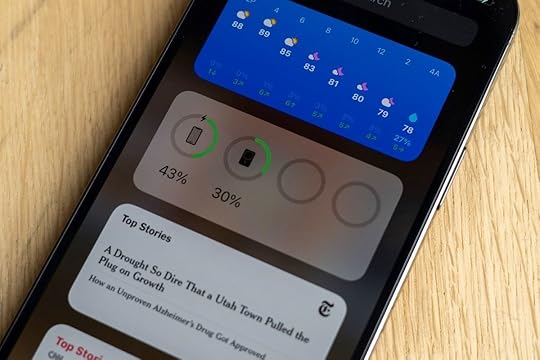 The MagSafe Battery Pack shows how much charge it has left in an iPhone widget.
The MagSafe Battery Pack shows how much charge it has left in an iPhone widget.After two days testing a couple different MagSafe Batteries on both an iPhone 12 Mini and iPhone 12 Pro Max, I came to a surprising conclusion. My favorite part isn’t the battery, it’s the MagSafe charger.
When I think of the MagSafe Battery as a MagSafe charging puck that just happens to have a battery attached to it, I think it makes a little more sense as a product. Apple’s MagSafe puck costs $40 — that certainly doesn’t make the $99 asking price for this battery a deal, but it might be worth buying the battery instead of the puck for some people.
I do have to point out that for $99 I would have expected Apple to at least include a Lightning cable. It doesn’t, nor does it include a charging brick.
When plugged into a powerful enough wall charger, the MagSafe Battery can charge the phone at up to 15W, just like the standard MagSafe disc. The charger can fill up both itself and your iPhone. If you want to prioritize charging speed on the iPhone, you can plug it in instead and then the iPhone will use reverse wireless charging to top up the battery. (Unfortunately and unlike Android phones, the iPhone’s reverse wireless charging doesn’t work for other devices, like AirPods.)
 The MagSafe Battery Pack can also wirelessly charge AirPods.
The MagSafe Battery Pack can also wirelessly charge AirPods.The MagSafe Battery’s best feature is that it is a good MagSafe wireless charger. It’s also a decent battery — but only if you think of it as a small extender, one that trades longevity for size. Do I wish it had more capacity? Of course. I also wish it could have more capacity without getting any larger than it already is. I don’t begrudge physics and I get why Apple chose the size it did.
But paying $99 for all the MagSafe Battery’s elegance and integration doesn’t make sense when there are much cheaper options that are less beholden to working with just one phone. A battery pack is going to look silly no matter what, you might as well get one that’s as versatile as possible.
The post Apple MagSafe Battery Pack review: convenience over capacity, Dieter Bohn appeared first on NEWDAWN Blog.
MagSafe Battery Pack teardown confirms dual-cell design, Jon Porter
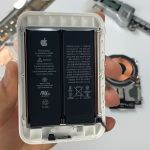
A teardown of Apple’s new $99 MagSafe Battery Pack from Charger Lab has given us our best look yet inside the new accessory, and revealed more details about how it works. For starters, it confirms recent speculation that it uses a pair of battery cells wired in series like Apple’s previous Smart Battery cases, but it also gives us a look at the NFC circuitry and heat shielding within.
A dual-cell design is important, because it allows the voltage of the battery pack to be higher than a comparable single-cell design. While each individual cell is labelled as being 3.82 volts, the overall voltage of the battery pack is 7.62 with them wired in series. It means the pack should be capable of supplying more power than its 1,460mAh capacity would suggest when compared directly with the battery capacities of the iPhone itself, with a total power output of 11.13Wh. AppleInsider has a good writeup of the science if you’re after more detail.
 The dual-cell design of the MagSafe Battery Pack.Screenshot: Charger Lab
The dual-cell design of the MagSafe Battery Pack.Screenshot: Charger LabBeyond the battery cells, the teardown gives us a good look at how the battery pack dissipates heat. In February, when Bloomberg first reported the existence of the pack, it noted that development had been set back because the iPhone’s software kept thinking the accessory was overheating. It’s unclear if this problem was overcome with software or hardware fixes, but clearly a lot of effort has gone into keeping the pack cool while allowing it to supply enough power.
Unlike the right-to-repair advocates over at iFixit, Charger Lab doesn’t offer a repairability score at the end of its teardowns. But the amount of adhesive and concealed tabs holding the battery pack together don’t make it look very user serviceable. We’ll have more details on how it performs in practice in our forthcoming review.
The post MagSafe Battery Pack teardown confirms dual-cell design, Jon Porter appeared first on NEWDAWN Blog.
Mars helicopter Ingenuity gearing up for 10th Red Planet flight this weekend, ,

The Martian flight tally of NASA’s Ingenuity helicopter will soon hit double digits.
The 4-lb. (1.8 kilograms) chopper’s 10th Red Planet flight could happen as early as Saturday (July 24), NASA officials said during a news conference on Wednesday (July 21).
The sortie will investigate “Raised Ridges,” they added. Raised Ridges is a collection of rock features inside Mars’ Jezero Crater from which Ingenuity’s robotic partner, NASA’s Perseverance rover, may end up collecting some samples for future return to Earth.
Perseverance and Ingenuity landed together on Feb. 18 on the floor of the 28-mile-wide (45 kilometers) Jezero, which hosted a lake and a river delta in the ancient past. In early April, Ingenuity deployed from Perseverance’s belly, kicking off a monthlong technology-demonstrating flight campaign.
Related: Ingenuity spotted a ‘heart’ in Perseverance rover’s tracks on 9th flight (video)
The rotorcraft aced all five of the sorties it conducted during that stretch. NASA then granted Ingenuity a mission extension, during which the helicopter is showcasing the scouting potential of Mars aerial vehicles.
For example, Ingenuity checked out a geologic unit called Seitah during its ninth flight, which occurred on July 5. Seitah sports a number of sand dunes, making it too tricky for Perseverance to traverse, even for tentative “toe-dips” to check out exposed bedrock. But Ingenuity’s imagery will help the rover team plan out possible toe-dip spots at other locations along its projected Jezero path, NASA officials said.
Ingenuity also captured some imagery of Raised Ridges during the July 5 sortie. But the helicopter and rover teams want more photos of the location, which is part of a fracture system through which liquid water may have flowed long ago.
The Ingenuity team has been pushing the helicopter’s capabilities during the extended mission. For example, on the ninth flight, Ingenuity traveled about 2,051 feet (650 meters), reached a top speed of 11 mph (17.7 kph) and stayed aloft for 166 seconds — all records for the little robot.
“I have to say, when we are all sitting there waiting for the data to come down, we were very relieved that the helicopter succeeded on that very ambitious flight,” Perseverance project manager Jennifer Trosper, of NASA’s Jet Propulsion Laboratory (JPL) in California, said during Wednesday’s news conference.
Perseverance’s main mission goals involve hunting for signs of past Mars life and collecting and caching dozens of samples, which will be returned to Earth by a joint NASA-European Space Agency campaign, perhaps as early as 2031.
Perseverance spent its first few months on Mars getting its systems up and running and supporting Ingenuity’s first few flights, but the six-wheeled rover is now focusing on its own needs. It has begun its life-hunting work and is preparing to collect its first sample, a milestone that could happen within the next two weeks, mission team members said on Wednesday.
Mike Wall is the author of “ Out There ” (Grand Central Publishing, 2018; illustrated by Karl Tate), a book about the search for alien life. Follow him on Twitter @michaeldwall. Follow us on Twitter @Spacedotcom or Facebook.
The post Mars helicopter Ingenuity gearing up for 10th Red Planet flight this weekend, , appeared first on NEWDAWN Blog.
Arm’s cheap and flexible plastic microchip could create an ‘internet of everything’, James Vincent
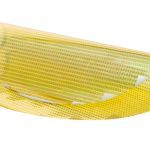
If you think microchips are ubiquitous now, appearing in everything from washing machines to lampposts, just wait until circuits can be printed onto plastic, paper, and fabric for the price of pennies. That’s what chip designer Arm is promising, with the company this week unveiling a new prototype plastic-based microchip named PlasticARM.
This isn’t the first flexible chip we’ve seen, but it is the most complex. PlasticARM contains a 32-bit Cortex-M0 CPU (the cheapest and simplest processor core in Arm’s Cortex-M family), as well as 456 bytes of ROM and 128 bytes of RAM. It’s comprised of over 18,000 logic gates, which Arm says is at least 12 times more than the previous plastic-based chip.
The chip was designed in coordination with flexible electronics maker PragmatIC, and as the company’s designers explain in a paper published in Nature, it doesn’t yet have the same functionality of silicon-based designs. For example, it’s only capable of running a trio of test programs hardwired into its circuits during fabrication, though Arm’s researchers say they’re working on future versions that will allow new code to be installed.
 Arm’s PlasticARM chip isn’t the fastest or most efficient, but it is the most flexible. Image: Arm
Arm’s PlasticARM chip isn’t the fastest or most efficient, but it is the most flexible. Image: ArmWhat makes PlasticARM and similar chips so special is their use of flexible components; in this case, metal-oxide thin-film transistors or TFTs. These can be printed onto surfaces that bend and flex without degrading, unlike processors based on brittle silicon substrates. This makes it possible to cheaply print processors onto materials like plastic and paper.
As Arm’s researchers explain in their paper, this would allow microchips to be put to all sorts of uses that would seem wasteful today. You might have chips printed into every milk bottle for example that detect spoilage, replacing the use of sell-by-dates. Arm says this will create a new “internet of everything,” with chips integrated into “more than a trillion inanimate objects over the next decade.”
Plastic-based chips have major drawbacks, though, and will certainly not replace silicon processors in the short term. They’re simply too inefficient in terms energy consumption, density, and performance. PlasticARM consumes 21 milliwatts of power, for example, but 99 percent of that is essentially wasted, with only 1 percent captured for computation. The chip is also comparatively large, with an area of 59.2 square millimeters. As noted by AnandTech, that’s around 1,500 times the size of a silicon-based Cortex M0 processor.
As Arm research engineer James Myers told New Scientist: “It won’t be fast, it won’t be energy efficient, but if I’m going to put it on a lettuce to track shelf life, that’s the idea.”
The post Arm’s cheap and flexible plastic microchip could create an ‘internet of everything’, James Vincent appeared first on NEWDAWN Blog.
July 22, 2021
NASA’s Perseverance rover gears up to capture its 1st Mars rock sample, ,

NASA’s Perseverance rover is preparing to collect its first samples on Mars, a milestone that could happen within the next two weeks, agency officials announced today (July 21).
Perseverance landed on the Red Planet in an ancient lake bed known as Jezero Crater on Feb. 18 to explore and scour the planet for signs of ancient life. To do this, the rover was designed to collect and store samples of Martian material to be returned to Earth by a mission in the early 2030s.
After beginning its science phase June 1 and exploring a 1.5-square-mile (4 square kilometers) region of the crater floor, Perseverance will take its first samples in an area known as the “Cratered Floor Fractured Rough.”
“When Neil Armstrong took the first sample from the Sea of Tranquility 52 years ago, he began a process that would rewrite what humanity knew about the moon,” Thomas Zurbuchen, NASA’s associate administrator for the science mission directorate said in a NASA statement. “I have every expectation that Perseverance’s first sample from Jezero Crater, and those that come after, will do the same for Mars. We are on the threshold of a new era of planetary science and discovery.”
“I just can’t tell you how excited I am,” Zurbuchen added during a news briefing today. He added that these months of exploration have laid “the groundwork for one of the most ambitious campaigns yet,” referring to the partnership with the European Space Agency to bring those samples back to Earth.
[image error]
A photo snapped by NASA’s Perseverance rover on Mars. (Image credit: NASA/JPL-Caltech)Perseverance will take approximately 11 days to collect its first sample, which it will do using its 7-foot-long (2 meters) robotic arm to first image and survey the site to determine an exact sampling location, then collect the material into a sampling tube. Shortly after the rover takes its first sample, it will take a second sample at a different target in the same general area for “proximity science,” or additional science, according to the NASA statement. The samples will each be finger-size cylinders stored in tubes.
The rover will then store the full tubes within its body for now; The location and date of their transfer to the sample-return mission is yet to be determined, Perseverance project scientist Ken Farley told Space.com in today’s briefing.
“Over the coming year, we will collect four unique samples, and we will keep them on board, we will carry them to a site which is not yet determined where we will cache them for future pickup,” Farley added.
While the samples will be thoroughly investigated once on Earth, Perseverance’s on-board technology will still be able to learn quite a bit about the rocks by studying the sampling sites.
Among other instruments on the rover are SHERLOC (Scanning Habitable Environments with Raman & Luminescence for Organics & Chemicals), PIXL (Planetary Instrument for X-ray Lithochemistry) and the camera WATSON (Wide Angle Topographic Sensor for Operations and Engineering). Using these three pieces of technology and other cameras, the rover can conduct mineral and chemical analysis of the site as well as collect detailed, high-resolution imagery.
7 minutes of terror: See the nail-biting Mars landing of the Perseverance rover
To get to this pivotal point in the mission, Perseverance has been going on what team leaders today described as a “road trip” across the Martian surface.
“We have a destination, we have a set amount of time, and we also have a lot of points of interest that are nearby or along the way that we really want to go and see,” Vivian Sun, the Perseverance science campaign co-leader, said today. The challenge, she described, is deciding “exactly where we want to go and how we’re going to fit everything into our schedule.”
The team has now selected their “road trip” sampling destination and an additional three points of interest along the way and, NASA announced today, they aim to take their first Martian sample within the next two weeks.
The rover will capture its first samples in an area known as the Cratered Floor Fractured Rough, which is about 3,000 feet (900 meters) south of where Perseverance landed in Jezero Crater, an area known as the Octavia. E Butler landing site.
The material here is crater terrain, Sun explained, “very similar to the terrain that you see on the moon.” The rover will also sample lighter-toned rocks that are usually covered by sand and dunes. “These are the two major rock types that we’re really investigating in this first science campaign,” Sun said.
Although a main science objective for Perseverance is to find evidence of ancient life on Mars, these samples will also provide scientists with data to explore the planet and its history.
“Not every sample Perseverance is collecting will be done in the quest for ancient life, and we don’t expect this first sample to provide definitive proof one way or the other,” Farley said in the statement. “While the rocks located in this geologic unit are not great time capsules for organics, we believe they have been around since the formation of Jezero Crater and incredibly valuable to fill gaps in our geologic understanding of this region — things we’ll desperately need to know if we find life once existed on Mars.”
To make the most out of their samples, the team wants to collect a sample that could represent the larger area. “We want this sample to really kind of summarize and record the history of this entire unit as much as possible,” Sun said in the conference. In particular, the Perseverance scientists want their sample “to have kind of the typical texture, chemistry and mineralogy as all the other crater floor fractured rock rocks that we have explored and seen so far on our trip.”
In fact, sampling this rock could solve a mystery that has been plaguing the mission team. While this crater is the site of an ancient lake, where scientists expect to find sedimentary rock, the team thinks that this region could possibly be volcanic rock instead.
“We still don’t know if it’s an igneous rock, like a volcanic flow, or if it’s a sedimentary rock that was deposited by air or in water,” Sun said. “And, of course understanding the origin of this Crater Floor Fractured Rock unit is going to be critical to not only reconstructing the history of this lake that used to be here but also it’s important for understanding the geologic history in general as well as the area around Jezero in this region of Mars.”
Email Chelsea Gohd at cgohd@space.com or follow her on Twitter @chelsea_gohd. Follow us on Twitter @Spacedotcom and on Facebook.
The post NASA’s Perseverance rover gears up to capture its 1st Mars rock sample, , appeared first on NEWDAWN Blog.
Oregon congressman proposes new space tourism tax, ,

People who buy joyrides to the final frontier could soon find an additional charge on their bill.
U.S. Rep. Earl Blumenauer (D-Oregon) plans to introduce legislation called the Securing Protections Against Carbon Emissions (SPACE) Tax Act, which would impose new excise taxes on space tourism trips.
“Space exploration isn’t a tax-free holiday for the wealthy. Just as normal Americans pay taxes when they buy airline tickets, billionaires who fly into space to produce nothing of scientific value should do the same, and then some,” Blumenauer said in a statement issued by his office.
“I’m not opposed to this type of space innovation,” added Blumenauer, a senior member of the House of Representatives’ Ways and Means Committee. “However, things that are done purely for tourism or entertainment, and that don’t have a scientific purpose, should in turn support the public good.”
Related: Jeff Bezos launches into space on Blue Origin’s 1st astronaut flight
Blumenauer unveiled the SPACE Tax Act idea on Tuesday (July 20), the same day that Jeff Bezos’ company Blue Origin launched its first crewed spaceflight. On that mission, Blue Origin’s New Shepard vehicle carried Bezos, his brother Mark, aviation pioneer Wally Funk and Dutch physics student Oliver Daemen to suborbital space and back.
Bezos’ flight came just nine days after fellow billionaire Richard Branson flew on the first fully crewed spaceflight of Virgin Galactic’s VSS Unity suborbital spaceliner.
Blue Origin has already begun commercial operations — Daemen was a paying customer — and Virgin Galactic aims to do so early next year, after performing a few more test flights this fall.
Virgin Galactic’s most recently stated ticket price was $250,000. Blue Origin has not revealed its prices yet, but they’re thought to be in the six figures as well. (Someone paid $28 million for a New Shepard seat in an online auction last month, but that was a special circumstance. The still-anonymous auction winner was supposed to fly on the July 20 mission but later backed out, and their seat was filled by Daemen.)
The proposed new tax would likely be levied on a per-passenger basis, as is done with commercial aviation, the statement said.
“Exemptions would be made available for NASA spaceflights for scientific research purposes,” the statement reads. “In the case of flights where some passengers are working on behalf of NASA for scientific research purposes and others are not, the launch excise tax shall be the pro rata share of the non-NASA researchers.”
There would be two taxation tiers, one for suborbital flights and another for missions that reach orbit. The statement did not reveal how much the tax would be in either case or if the collected revenue would be earmarked for any specific purpose.
Such a purpose could be the fight against climate change, if the proposed act’s full name is any guide. Blumenauer is concerned about the potential carbon footprint of the space tourism industry once it gets fully up and running, the statement said.
Mike Wall is the author of “ Out There ” (Grand Central Publishing, 2018; illustrated by Karl Tate), a book about the search for alien life. Follow him on Twitter @michaeldwall. Follow us on Twitter @Spacedotcom or Facebook.
Join our Space Forums to keep talking space on the latest missions, night sky and more! And if you have a news tip, correction or comment, let us know at: community@space.com.
The post Oregon congressman proposes new space tourism tax, , appeared first on NEWDAWN Blog.
Europe’s Mars orbiter finds no trace of methane on Red Planet, ,
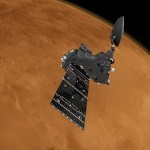
A joint European-Russian spacecraft orbiting Mars has found no signs of gases related to the existence of life in the atmosphere of Mars, according to three new studies.
Scientists were hunting for telltale signs of methane gas in data from a spacecraft called the Trace Gas Orbiter, which arrived at Mars in 2016 as part of the ExoMars mission by the European Space Agency (ESA) and Russia’s Roscosmos. Specifically, they used two instruments to look for traces of methane, as well as the byproducts of its chemical reactions triggered by sunlight, ethane and ethylene.
But despite gathering over two and a half years worth of measurements from one of the instruments (called the Atmospheric Chemistry Suite, or ACS) and over a year’s worth of data from the other (known as Nadir Occultation MArs Discovery, or NOMAD) the researchers found no trace of their target gases, ESA said in a statement. A separate team, which was looking for another possible signature of life in the atmosphere of the planet, the presence of phosphines, was also unsuccessful.
Related: The search for life on Mars: A photo timeline
The findings are in contrast with measurements obtained by NASA’s Curiosity rover, which detected occasional bursts of methane in the lower layers of the atmosphere of Mars as well as near its surface. The ground-based measurements estimated there might be up to 30 molecules (parts) of methane in every billion molecules in the atmosphere of the planet. But the newest measurements by Trace Gas Orbiter indicate a maximum of 0.05 molecules per billion, but more likely only 0.02 molecules per billion.
Hunting methane on MarsThe new results follow on estimates released in 2019, which contained Trace Gas Orbiter data from a shorter period of time.
The researchers concluded that since the instruments aboard the spacecraft are extremely sensitive, the concentration of methane in the upper atmosphere of Mars, if the gas is present there at all, must be extremely low in order to prevent detection over such a long period of time. They, however, still believe the gas might be present closer to the surface.
“Curiosity measures right at Mars’ surface while the orbiter takes measurements a few kilometres above,” Franck Montmessin, a scientist at the Laboratoire Atmospheres, Observations Spatiales (LATMOS), France, and lead author of the paper based on the ACS data, said in the statement. “So the difference between these two findings could be explained by any methane being trapped by the lower atmosphere or the immediate vicinity of the rover.”
The scientists, in fact, attempted to detect methane also above Gale Crater, the area explored by the Curiosity rover.
Measurements obtained by the NOMAD instrument in the period of one year, which were published in a separate paper, showed the same result.
Related: ExoMars’ first high-res photos are incredible
[image error]
The ExoMars Trace Gas orbiter found no signs of life in the atmosphere of Mars. (Image credit: ESA)“As well as searching for global methane, we also looked for localised plumes at over 2,000 locations on the planet and didn’t detect anything,” Elise Wright Knutsen, also of LATMOS, said in the statement. “So if methane is released in this way, it must be sporadic.”
The NOMAD study also, for the first time, looked for the byproducts of methane’s chemistry, ethane and ethylene, in the atmosphere of the planet. The results, however, were equally disappointing.
“We didn’t detect either, and so set upper limits for ethane and ethylene at 0.1 and 0.7 parts per billion, respectively — low, but higher than our limits for methane,” Knutsen said.
As both of these gases have rather limited lifespan, their detection by the instrument would mean that they must have been produced fairly recently.
Methane and phosphine on Mars?Methane, which could be found in Earth’s atmosphere in quantities of nearly 2,000 molecules (parts) per billion, could be either produced by living organisms or generated in geological processes. The scientists, however, cannot distinguish between the biologically and geologically produced gas.
Another study, looking at the presence of phospines, the same organic compounds that were reportedly detected in the atmosphere of Venus last year, also emerged with disappointing results.
“We didn’t find any signs of phosphine at Mars,” Kevin Olsen of the University of Oxford, UK, and lead author of the phosphine study said in the statement. “Our upper limits are similar for those of ethane and ethylene — between 0.1 and 0.6 parts per billion.”
Phospines on Earth, unlike methane, are usually produced by bacteria and could therefore be considered a more conclusive evidence of life. However, the scientists behind the ExoMars project don’t let the findings tamper their excitement about the upcoming second part of the mission, the launch of the Rosalind Franklin rover to the Red Planet, which is scheduled for September next year. Fitted with a two-meter drill, the rover will search for traces of life way deeper underground than the existing rovers, where potential microorganisms might be protected from the harsh environment on the surface.
“Whether biomarkers are detected or not, these findings are important for our understanding of which processes occur, and which do not, in the martian atmosphere — essential information when considering where to focus our continued investigation of Mars,” Hakan Svedhem, ESA Project Scientist for the ExoMars Trace Gas Orbiter, said in the statement.
The three papers have been published in the journals Astronomy and Astrophysics, and Icarus.
Follow Tereza Pultarova on Twitter @TerezaPultarova. Follow us on Twitter @Spacedotcom and on Facebook.
The post Europe’s Mars orbiter finds no trace of methane on Red Planet, , appeared first on NEWDAWN Blog.
Meet SuperBIT, the next-generation space telescope that rides above the clouds on a balloon, ,
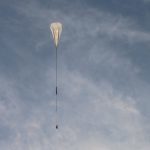
A new type of space telescope could soar high above Earth‘s clouds to view the universe in a more environmentally-friendly and upgradable way than current technologies.
The Superpressure Balloon-borne Imaging Telescope (SuperBIT) was announced on Tuesday (July 20) by the Royal Astronomical Society (RAS). Its creators include researchers from Durham University in the United Kingdom, Princeton University and the University of Toronto in Canada, who partnered with NASA and the Canadian Space Agency.
The team’s claims about SuperBIT indicate that this novel space telescope might be the next best thing in astronomy. “New balloon technology makes visiting space cheap, easy and environmentally friendly,” Mohamed Shaaban, a doctoral student at the University of Toronto, said in the announcement. Shaaban described SuperBIT on Wednesday (July 21) at the virtual RAS National Astronomy Meeting (NAM 2021).
Related: The best Hubble Space Telescope images of all time!
[image error]
The SuperBIT balloon in flight, above NASA’s Columbia Scientific Balloon Facility, Texas, in June 2016. (Image credit: Richard Massey/Durham University (CC BY 4.0))SuperBIT’s helium balloon is one of the showstopping new technologies the project incorporates. The balloon is the size of a football stadium, according to the statement, with a volume of 695,830 cubic yards (532,000 cubic meters). The floating orb is powerful enough to carry a telescopic mirror to an altitude of about 25 miles (40 kilometers), about the same altitude as the top of Earth’s stratosphere.
That altitude is important because while Earth’s atmosphere is a crucial part of our planet, it does interfere with astronomical observations, blurring precious images. Reaching the top of the stratosphere would allow astronomers to observe the universe with little to no interference from the atmosphere. Unlike current balloons, SuperBIT also boasts a “superpressure” balloon that can keep the telescope aloft high in the sky for months at a time instead of days.
The perks continue with its imaging capabilities. SuperBIT’s final test flight in 2019 showed that it can stay on its observation target with “variation of less than one thirty-six thousandth of a degree for more than an hour,” according to the statement. This should enable SuperBIT to get high-resolution images equal or better to those from the iconic Hubble Space Telescope. The first SuperBIT flight will carry a telescope with a 19.7-inch-wide (0.5 meters) mirror, but a design upgrade will include a 39.4-inch (1.5 m) aperture and this could make SuperBIT “even better than Hubble,” the scientists hope.
[image error]
SuperBIT’s final preparations for launch from Timmins Stratospheric Balloon Base Canada, in September 2019. (Image credit: Steven Benton, Princeton University (CC BY 4.0))The balloon-lofted model makes upgrades easier to perform, too. Teams using SuperBIT could swap out the telescope’s cameras or instruments with updated versions. Unlike traditional space telescopes, SuperBIT returns to Earth periodically so it wouldn’t be locked to a certain type of hardware in perpetuity. “SuperBIT can be continually reconfigured and upgraded,” said Shaaban.
Balloons don’t require rocket fuel, making them more environmentally friendly than fuel-based lifting procedures. They are also cheaper than similar satellites, according to the statement. “With a budget for construction and operation for the first telescope of $5 million (GBP3.62 million), SuperBIT cost almost 1,000 times less than a similar satellite,” RAS officials said in the statement.
SuperBIT’s first operational flight is currently scheduled for April 2022. It will lift off from Wanaka, New Zealand, and circumnavigate Earth several times to take images of the night sky; during the day, it will recharge its batteries using solar panels.
Follow Doris Elin Urrutia on Twitter @salazar_elin. Follow us on Twitter @Spacedotcom and on Facebook.
The post Meet SuperBIT, the next-generation space telescope that rides above the clouds on a balloon, , appeared first on NEWDAWN Blog.
Twitter’s new beta TweetDeck is so bad I’m ready to ragequit, Sean Hollister

I counted: 31 tweets. That’s how many I could see in my traditional TweetDeck window the other day. But at that same moment, TweetDeck’s new preview only showed me 21 tweets — 38 percent less, and that’s with the narrowest columns and the smallest font available, just to be clear.
For over a decade, people have sworn by TweetDeck as the power user alternative to the original Twitter app, but what most people really mean is one specific thing: it lets you see more tweets. TweetDeck lets you see more tweets without needing to scroll. It gives you an entire dashboard of tweets you can throw up on a monitor, unattended. The power of TweetDeck is that it’s glanceable, a way to passively tap into a firehose of personal interests. That’s why it’s such a powerful tool for the world’s newsrooms, and a tool The Verge uses daily.
It’s also why I can’t comprehend how Twitter could have let this new version of TweetDeck into the world, even in beta form. I’m now worried Twitter has forgotten why we use TweetDeck.


If you break it down, there are easily half a dozen little culprits, each maybe forgivable on its own:
There’s a lot of wasted space around tweets.Reply, retweet, and like buttons have been spaced out, and take up more room.TweetDeck’s left rail is wider, for no discernible reason.Twitter lists inexplicably come with an “overview” at the top, one that leaves an ugly “show overview” button even if you minimize it.Tweet previews inside of tweets (i.e. quote tweets) now take up far more vertical space.Scroll bars are chunkier now, because they’re browser native unlike the previous custom bars — and on Chrome, they don’t seem to render properly in dark mode.Together, these changes add up to a less glanceable TweetDeck, whether you’ve got it up on a dedicated portrait monitor (like me) or not. I’m frustrated my 16:10 monitor can no longer fit four full columns without changing my browser zoom, but it might honestly be worse in landscape: if you follow people who retweet a lot of things, you’ll be lucky to see four at a time in any given column before they slide out of view.
When Twitter teased the new TweetDeck on Tuesday, the kneejerk reaction was that our precious columns might have been done away with for good, due to a teaser image that — to put it mildly — didn’t cater to TweetDeck’s power users. Hours later, Twitter realized its mistake, tweeting out “Don’t worry! Your favorite TweetDeck features aren’t going away,” suggesting that columns are alive and well. Twitter’s Eric Zuckerman, who helps the company partner with news publishers, even defended the design by tweeting a picture of his own:
I’ve been using the new TweetDeck preview for 9 months. If you’re a longtime user and thrown off by the image below, rest assured you can customize your columns to look and behave very much like the version you know and love. For example, here’s mine: pic.twitter.com/i9bT1Mkfr8 https://t.co/16dHgdVXAQ
— Eric Zuckerman (@EricZuck)
And yet some of Zuckerman’s columns only let you see two large tweets at once. Two.
The new TweetDeck has some silver linings. I’m happy Twitter’s bringing over its new composer and direct messages box from Twitter.com. It’s nice to have more fine-tuned control over images, for instance, and you might argue that the pop-up messages box saves you having to erect a dedicated column for them (though, for The Verge‘s private news account, it’s just blocking part of our view). And while I could care less about being able to switch between “decks” filled with columns from a single Twitter account, a la virtual desktops, I’m sure some social media managers are excited.
 The new TweetDeck composer has reached parity with Twitter.com, and looks identical.
The new TweetDeck composer has reached parity with Twitter.com, and looks identical.The new Notifications column is neat too, letting you easily see alerts for particular users and when your tweets have been liked and retweeted, instead of just seeing when you’ve been mentioned. That, plus columns for your own profile, Twitter’s explore tab, events, topics, moments and advanced Boolean search could make TweetDeck a complete alternative to Twitter, instead of occasionally making you swap between the two.
But a few creature comforts aside, I’m not looking for TweetDeck to be more like Twitter.com. Vanilla Twitter already exists, and it’s only a click away. (Or at least, it was until TweetDeck Preview added its own TweetDeck.com URLs for individual tweets, yuck.) I picked TweetDeck because it was more efficient, just like I picked a number of third-party Twitter apps back when those were a thing, before Twitter rate-limited most of them to death and kept them from properly auto-refreshing tweets as they came in.
Ironically, I’m having a little bit of trouble there with the TweetDeck Preview, too: if I step away from the new TweetDeck window for a while I find that the auto-refresh feature doesn’t always keep popping new tweets into my view. Twitter says TweetDeck currently tries to keep your current scroll position so you don’t lose track when more tweets come in, but that it wants feedback. (My feedback: make “don’t auto-scroll” a toggle.)
Twitter tells me it’s already seeing plenty of early feedback that tweet density is important to people, and that feedback is the point of pushing this preview out into the world. The company wants to explore what it should actually include in the final version, and criticism like mine can help. Oh, and it’s especially important here because Twitter’s expecting people to pay for this new version of TweetDeck. “With this test, we hope to gather feedback to explore what an enhanced version of TweetDeck could look like within Twitter’s subscription offerings later on,” writes a spokesperson.
I sure hope so, because there aren’t an awful lot of things keeping me on Twitter these days except for TweetDeck’s efficiency, and this preview version is less efficient on practically every front. If Twitter blows up TweetDeck, I won’t just decline to pay — I’ll probably leave Twitter for good.
The post Twitter’s new beta TweetDeck is so bad I’m ready to ragequit, Sean Hollister appeared first on NEWDAWN Blog.



